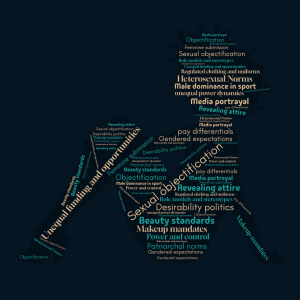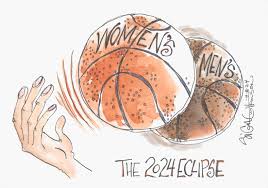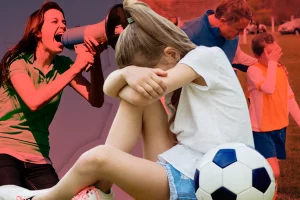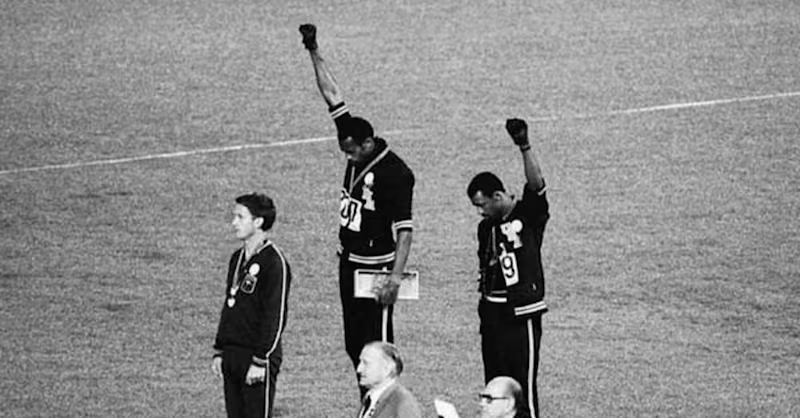1
Section One: The Fundamentals
A) What do we know about sport? What are common assumptions we make about sport and society?
| Playing sports is becoming more for the elite, as the high costs of equipment, training, and fees make it too expensive for many families with lower incomes. While sports are often seen as a way to move up in life, not everyone gets the same chance. People from low-income families face barriers that make it harder to enjoy the benefits of sports, like scholarships or job opportunities. This growing gap shows the need for more affordable and inclusive options so everyone can take part. |
Exercise 3: Notebook prompt
What are some other metanarratives about sport that you are familiar with? Find an image or video clip or draw something yourself that captures this idea…
So what? Why does any of this matter? Does it matter? As something we grow up with – live with – play through – we don’t often interrogate the meanings of sport, and perhaps we don’t want to.
But being aware of these assumptions and metanarratives is especially important, I would argue, because of the centrality of sport to our everyday lives, the role that sport plays in shaping our childhood and worldviews and….. [finish that thought]
|
One metanarrative about sport that this image captures is the belief that sports are always positive experiences for children, teaching them teamwork, discipline, and resilience. However, this image challenges that assumption, showing the negative side of sports culture, where overbearing parents, demanding coaches, and extreme pressure can harm children’s mental and emotional well-being. The young girl’s body language—head down, arms crossed, and visibly upset—represents the stress and burnout that can occur when sports become more about meeting adult expectations than about fun and personal growth. So what? Why does this matter? Being aware of these assumptions is important because it highlights the need to create sports environments that are inclusive and supportive. Sports should focus on fostering joy, confidence, and personal growth rather than stress and alienation. By addressing these issues, we can ensure that all children feel valued and supported in their athletic experiences. |
B) What is social justice?
Exercise 4: Padlet Prompt
Think back to the last section and try to look at some of the ideas we discussed differently. How might sport and social justice actually co-exist?
Record any images, video clips, or gifs you added to the padlet and identify a point of intersection between sport and social justice (can be an issue or a barrier or a debate or something you would like to explore in more depth in this course) . Screenshot or paste in your response below.
|
The Black Power salute at the 1968 Olympics is a powerful example of how sport and social justice can go hand in hand. During the medal ceremony, Tommie Smith and John Carlos raised their fists to actively protest and draw attention to systemic racism and inequality faced by Black communities. This deliberate act of defiance turned a sporting event into a global stage for advocacy and activism, highlighting the courage required to stand up for social justice. At its core, this moment falls under Advocacy and Activism, as Smith and Carlos used their platform to demand change and raise awareness. However, it also touches on Equality and Representation, shedding light on the lack of representation and equitable treatment of Black people in society, including within sports. Their gesture called for structural changes to address these disparities, tying it to the broader fight for equality.
|
C) Social Justice Reading
(note: this activity is optional!)
D) KINESIOLOGY AND SOCIAL JUSTICE
Exercise 5:
Exercise 6:
What are the implications of bodies-at-risk discourse and the refusal to understand the health gap from a social justice perspective, according to the authors of this article?
| Reinforcing Negative Stereotypes: Marginalised groups are labelled as “problems to be fixed,” which fuels harmful stereotypes and ignores systemic issues that cause health disparities.
Hiding Structural Inequalities: By focusing on personal responsibility, this approach diverts attention from larger barriers like poverty, racism, and lack of access to resources. Favouring Privilege: The narrative centres White, middle- and upper-class norms, dismissing diverse cultural perspectives and needs. Profit Over People: Health becomes a commodity, prioritised for profit by industries rather than addressing real causes of inequality. Widening the Gap: Without tackling systemic oppression, the divide between privileged groups and marginalised populations grows deeper. Silencing Marginalised Voices: Ignoring social justice perspectives erases the experiences of marginalised communities, excluding them from shaping their own health solutions. |
Section Two: Sport Feminism
Exercise 7: Notebook Prompt
What is feminism? What does it mean to you? Choose one of the images below and explain how it captures your understanding of feminism (or find one that does speak to you and paste this into your pressbook with an explanation of why it matters to you.
|
All of the images supplied are fantastic examples of feminism. The sole reason I selected this image is that it shows an absolute disregard for societal norms at the time. It depicts individuals, regardless of race or class, walking arm in arm, breaking the barriers of segregation and inequality. This image symbolises solidarity and the shared struggle for justice, showing that feminism isn’t just about gender equality but also about dismantling systems of oppression that affect all marginalised groups. It captures the courage and unity required to challenge deeply ingrained societal injustices, inspiring us to continue fighting for intersectional equality today. |
Exercise 8: Notes Prompt (optional)
NB: Cornell notes is a great resource that teaches effective notetaking. Unfortunately, our system can’t save notes taken in the H5P app, so this is fully optional.
Exercise 9: Crossword Activity
Exercise 10: Padlet Prompt

I think I got stuck on key issues from the chapter and hyper-fixated on the objectification and sexualisation of women athletes, as it is often highlighted. Focusing on this issue underscores a critical problem in sport that reflects persistent gender inequality. Female athletes are frequently valued more for their appearance than their skill or achievements, perpetuating harmful stereotypes and reinforcing patriarchal norms. Addressing this concern challenges the media’s role in commodifying women’s bodies, advocates for equitable representation, and creates opportunities for female athletes to reclaim their agency. It also connects to broader societal discussions on gender, power, and body image, pushing for systemic change and greater respect for women across all aspects of life. |

| I hope this is not just a temporary trend, but until we see meaningful change in the media’s portrayal of sports, it will be challenging to sway public opinion. Male commentators often make jokes about the WNBA or dismiss past attempts to establish a women’s professional hockey league, reinforcing outdated perceptions. However, what gives me hope is the emergence of the PWHL, the difficulty in securing tickets to their games, and the growing buzz around a WNBA team potentially coming to Toronto. These developments show that the league is expanding, and interest is increasing.
What truly inspires me is seeing how much my eldest gravitates towards women’s sports—she won’t watch men’s games, but she’s captivated by female sports programmes. With more representation available, I’m optimistic that more people will tune in, inspiring new generations of athletes and fuelling the growth of women’s sports even further.
|




